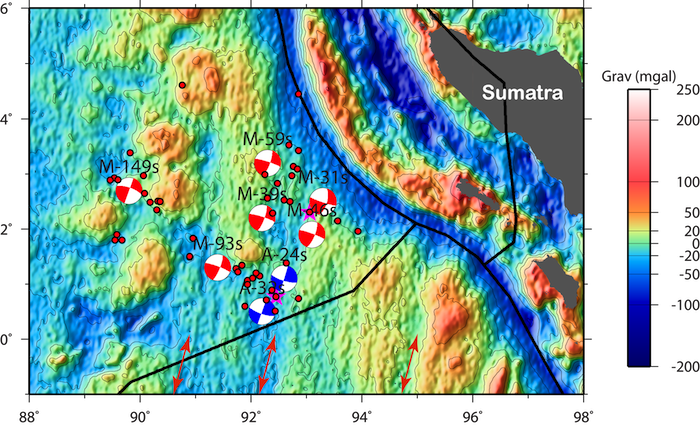2012 IRIS Workshop
A Multiple Double Couple Analysis of the April 11, 2012 Mw 8.6 Off the West Coast of Sumatra Earthquake and its Largest Aftershock
Chen Ji: UCSB; Guangfu Shao: UCSB, Gavin Hayes: NEIC, USGS; Xiangyu Li: UCSB
Figure 1. MDC solutions of April 11, 2012 Mw 8.6 and 8.2 earthquakes offshore of Sumatra, overlain on the regional free gravity anomaly. Plate boundaries from Bird (2003) are indicated with thick solid lines. Red arrows denote the locations of inferred fossil fracture zones. Purple stars indicate the USGS PDE epicenters of the two events; red circles denote subsequent aftershocks. The labels above each focal mechanism represent the centroid time in seconds, with the M- or A- denoting the mainshock or aftershock, respectively.

Full-resolution graphics file in original format: 0112.png
On April 11, 2012, an Mw 8.6 earthquake occurred beneath the Indian Ocean off the west coast of northern Sumatra, Indonesia. Two hours later, its largest aftershock happened with an Mw of 8.2. The USGS W-phase moment tensor analysis suggests that both events were dominated by either left-lateral strike-slip motion on a north-northeast striking fault, or right-lateral slip on a west-northwest striking fault, consistent with the focal mechanisms of historic earthquakes in this region. The April 11 mainshock is then the largest strike-slip earthquake ever recorded with modern instruments. Here we approximate the rupture processes of these two events as multiple double couples (MDC), and apply a simulated annealing algorithm to simultaneously invert for the strike, dip, rake, moment, centroid location and centroid time for each point source by fitting the waveforms of the 3-10 mHz Rayleigh and Love waves. We find that to match the long period waves of the mainshock at least six double-couple point sources are required, while matching those of the aftershock also implies two point sources. The spatiotemporal distribution of these point sources suggests that the mainshock rupture included two stages. The first involved left-lateral bilateral rupture on two sub-parallel north-northeast oriented fault planes near the mainshock hypocenter. The rupture initiated on the easternmost fault plane but triggered the rupture of westernmost fault plane before the rupture on the east fault was complete. This stage of the rupture had a duration of about 80 s and released three quarters of the total mainshock seismic moment. The second stage of the mainshock rupture was composed of two sub-events with centroid times of 93 s and 150 s, suggesting a unilateral rupture on a west-northwest oriented fault plane. The relative locations of these sub-events are also consistent with the west-northwest trending aftershock zone. Finally, our analysis of the large aftershock suggests it propagated
Acknoweldgements: We thank to IRIS data management center for providing broadband teleseismic waveforms and to Professor David Sandwell for providing local gravity anomaly data. This work was supported by NSF grant EAR-0911769.
Keywords: april_11, 2012_mw_8.6_sumatra_earthquake, multiple_double_couples
